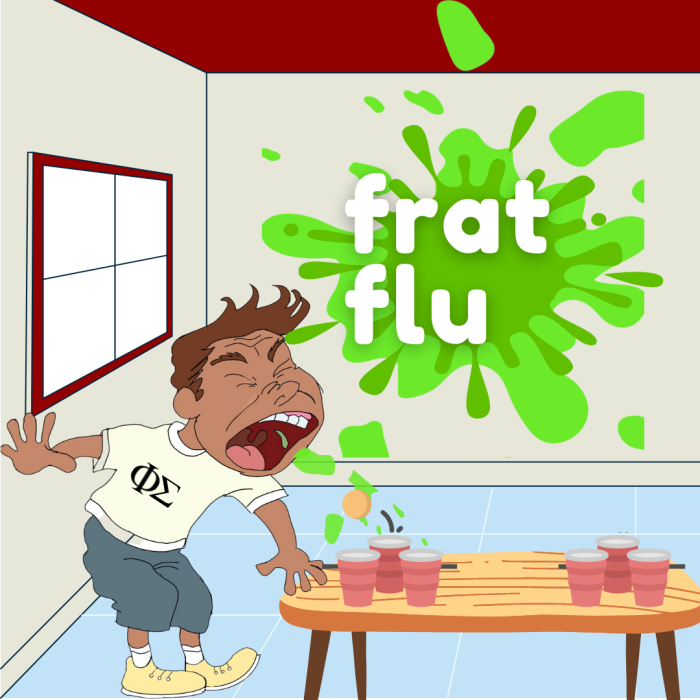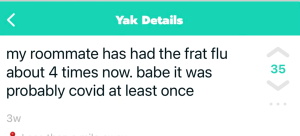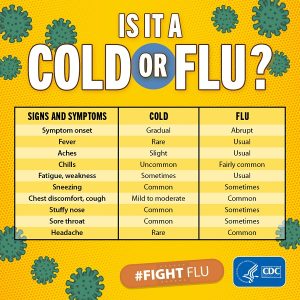
Water splashes on your face as you look in the mirror. You look like hell. You stumble into the kitchen and shuffle around the cupboard for the nearest shot glass.
No, this is not about a drunk college night. It’s frat flu season. The only thing you will be throwing back is a shot of Nyquil PM.
“We may not have frat houses, but we do have frat flu,” said Emma Rivelle, a junior communication major at Chapman.
Rumor has it that frat flu — named because it used to concentrate among Greek groups — has encroached itself on Chapman campuses. As the strange, cold-like illness festers its way across universities across the nation, noises of coughs and sniffles have gradually filled up the CU halls.
“It’s getting passed around so easily and no one can get over it. I have had a cough for like a month now,” said Caleb Taormina, a sophomore member of the greek life community.
There is an increase in the attention given to personal health, as well the health of those around us in the wake of the COVID-19 era. As topics regarding health maintain a higher rank in the trending category across media outlets, college students have taken to the internet to discuss the buzz around frat flu.
Online communities of undergrads have given the common-cold a rebrand, college style.

Although frat flu is not a medically recognized illness, senior Isabella Deangelo defines it as the “general sickness that you wake up with in the morning after going out.”

In a survey with Chapman students, over 77% of respondents reported being affected by frat flu at some point this semester.
With respondents reporting symptoms including: cough, congestion, nausea, body aches, sore throat and fatigue, it appears that frat flu is more than just a bad hangover.
However rather than the actual flu, the Director of Student Health Services at Chapman, Jacqueline Deats, says in her observation, the frat flu is just another name for a “viral syndrome” we know as the common cold.
While the common cold and the flu produce similar symptoms, the Centers for Disease Control states:
“In general, flu is worse than the common cold, and symptoms are typically more intense and begin more abruptly. Colds are usually milder than flu.”

Deats says in regards to the fall and winter seasons, the health department “always gets busy this time of year” with these cases.

“It’s been a long semester so far, people are tired and worn down,” said Deats.
A long semester for Panthers indeed. With classes back in person, students have had to adjust to the physical aspect of school.
“I mean we’re just doing a lot more than we did last year when I could just do everything on zoom from my bed. In-person, which I am grateful for, just takes a lot more out of me energy wise than it did last year,” said Mady Mracheck, a dance major.

In addition, junior Jamie Johnson believes widespread frat flu across campuses this year can be attributed to germ spread of going back in person.
“There were really no gatherings, shared desks or public bathrooms for any of us to get sick or spread germs from last year. Our bodies are having to re-build their immunity back up again,” said Johnson, a member of Gamma Phi Beta sorority chapter.
While seasonal viruses can affect anyone going back in person, the general consensus of frat flu is an illness that targets fraternity party goers.
In a student survey, one person wrote that “frat flu affects the students that go out frequently and get sick with the same symptoms from drinking and being in a petri dish of germs. ”
Another student in the survey added, “Frats are nasty and most definitely a breeding ground for infectious illness. Therefore if you frequent these gnarly places, you run the risk of catching the frat flu.”

It is true there is nothing clean about a frat party–as liquor handles and vaping devices get passed around the dance floor, germs and viruses are often the party favors attendees take home afterwards.
Meanwhile, health science major, Chanse Corbi, would argue that some of the fraternity households she has been in appear to have gone decades without being properly cleaned.
“I am lucky if I can even find hand soap in the bathroom, let alone toilet paper. It is frat flu headquarters in there,” said Corbi.
Other students like Deangelo believe ground zero for frat flu is the dance floor.
“It’s dark, everyone is sweaty and dancing on top of each other. It’s obvious why everyone gets sick from each other,” said Deangelo.
Nevertheless, the party still lives on. With fraternity gatherings being a weekly event students look forward to, frat flu might not be rolled any time soon.
As students approach the final weeks of the semester, which is known to be followed by a variety of celebratory events and parties, Deats offers words of advice for how students can better protect themselves and others heading into this next week:
“Just practice good basic hygiene. Drink plenty of fluid, get adequate hours of sleep every night, eat healthy protein filled meals. Get a flu shot if you haven’t already.”

Macy Meinhardt is a junior studying journalism at Chapman University. From a very young age, Macy fell in love with the art of expression and storytelling through dance and music, which eventually illuminated her path in writing.
Macy Meinhardt is a junior studying journalism at Chapman University. From a very young age, Macy fell in love with the art of expression and storytelling through dance and music, which eventually illuminated her path in writing.
